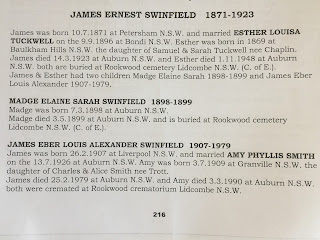Having conducted research in the history of the Swinfield family for 50 years, since I began my study in 1972, I thought that I knew of all the main sources of information which are available for its investigation. You never should say that there is nothing else to look at!
Recently, I became aware, during recent online correspondence with Linda Swinfield of New South Wales, of a privately-printed work which includes a very significant account of the genealogy of the branch of the family which I call Swinfield Family 3A. The book is entitled Caroline Eleanor Burrows/Ferrier nee Meredith 1813-1893 Burrows Descendents and was compiled and produced by Val Ferrier of Waratah in 2000. Why did this contain such a wealth of information about those called Swinfield, especially the branch that has lived in New South Wales from the mid 19th to the end of the 20th century?
Val's quest was to identify the descendants of Caroline Meredith, who was born on 17th November 1813 in Sydney, NSW, as the daughter of Frederick Meredith and his wife, Sarah Mason, who he married in 1811. Frederick was on the First Fleet as a steward on the “Scarborough” arriving in Sydney on 26th January 1788. He eventually became the first Chief Constable of the Sydney Police and died there in 1836. There is a Facebook Group where his descendants engage in discussion of his family's history. In an attempt to locate branches of Caroline’s descent, from the 16 children that she had by her two husbands, John Burrows (1794-1859) and Frederick Robert Ferrier (1813-1882), she sent out many “information sheets” on which living relatives could provide their genealogical information. She then compiled a spiral bound book of 236 pages of text, photographs and pedigrees just for the Burrows descendants.
The fifth section of this epic work, pages 177-235, recounts the descendants of the seventh of the eight children who Eleanor had by John Burrows. That was Ellen Sophia (1840-1890) who was to marry John Swinfield (1838-1903) on 25th June 1858 at St Andrews Scots Church, Sydney.
 |
| 1858 marriage of John Swinfield & Ellen Sophia Burrows |
John had arrived on 30th December 1848 aboard the “Walmer Castle” as the 10 year-old son of William Swinfield (1804-1876) and his step-mother Sarah (Williamson) (1816-1861).
 |
| John Swinfield arriving in 1848 with his family (NSW State Archives: NRS5316/4_4786) |
John had been born at Hartshill in Warwickshire, England, on 22nd July 1838. His mother Sarah (Ballard) had died in 1845. John and Ellen Sophia Swinfield had ten children of their own, born from 1858 to 1879 in Sydney.
Three of their issue died as infants and although two of their other children grew up and married, they had no issue who survived infancy. Of the five children, whose living descendants are documented in Val’s book, four were sons. Those were Henry Swinfield (1858-1923), Albert William (1866-1934), Arthur Thomas (1868-1917) and James Ernest (1871-1923). All have living Swinfield lines of descent.

NSW has no publically-available census for the 20th century as I referred to in my blog about the 1921 census of England and Wales. This lack of data can be supplemented by some information found in the Ryerson Index of newspaper obituaries and death announcements. If the family can be contacted, and I am in contact with representatives of many NSW families, they can, of course, help with vital information about the more recent generations.
The most important new information concerns the descendants who were born after 1921. 1921 is the latest year which can currently be searched through the online state birth index for NSW. The limitation is due to a 100 year confidentiality regulation. In the absence of the birth index information from 1922 to the present, clues from the marriage index, which are now available to as late as 1971, and the death index which can be searched to 1991, it is almost impossible to build trees to the present-day
Now that we have access to the wealth of information gleaned and compiled by Val Ferrier to as late as 2000, this reveals other Swinfield lines of descents through those people who were born in the last eight decades of the 20th century where an “information sheet” was completed and returned. All the new names, dates and places have now been added to my databases and the pedigree for Swinfield Family 3A. Thank you Linda and Val!


.jpg)
.jpg)